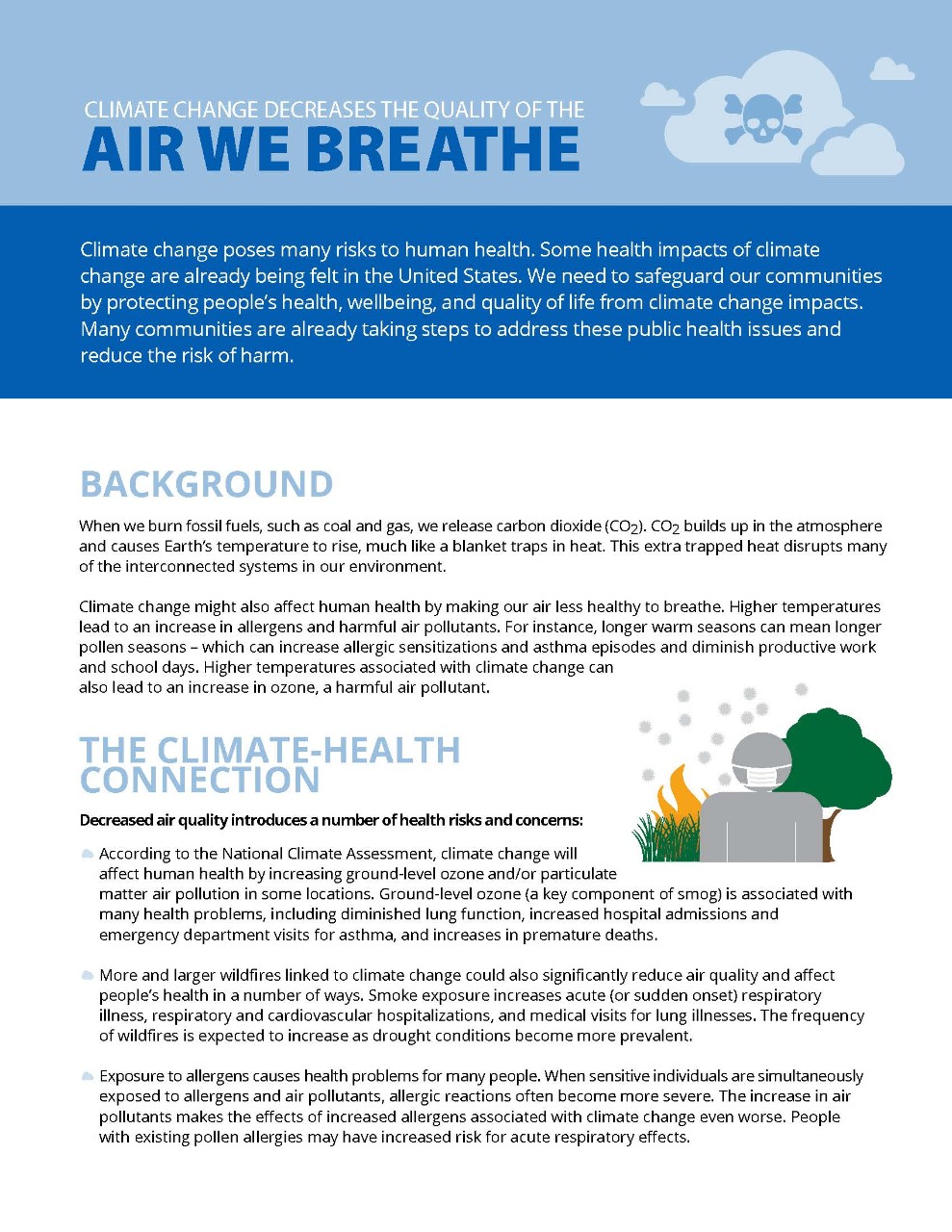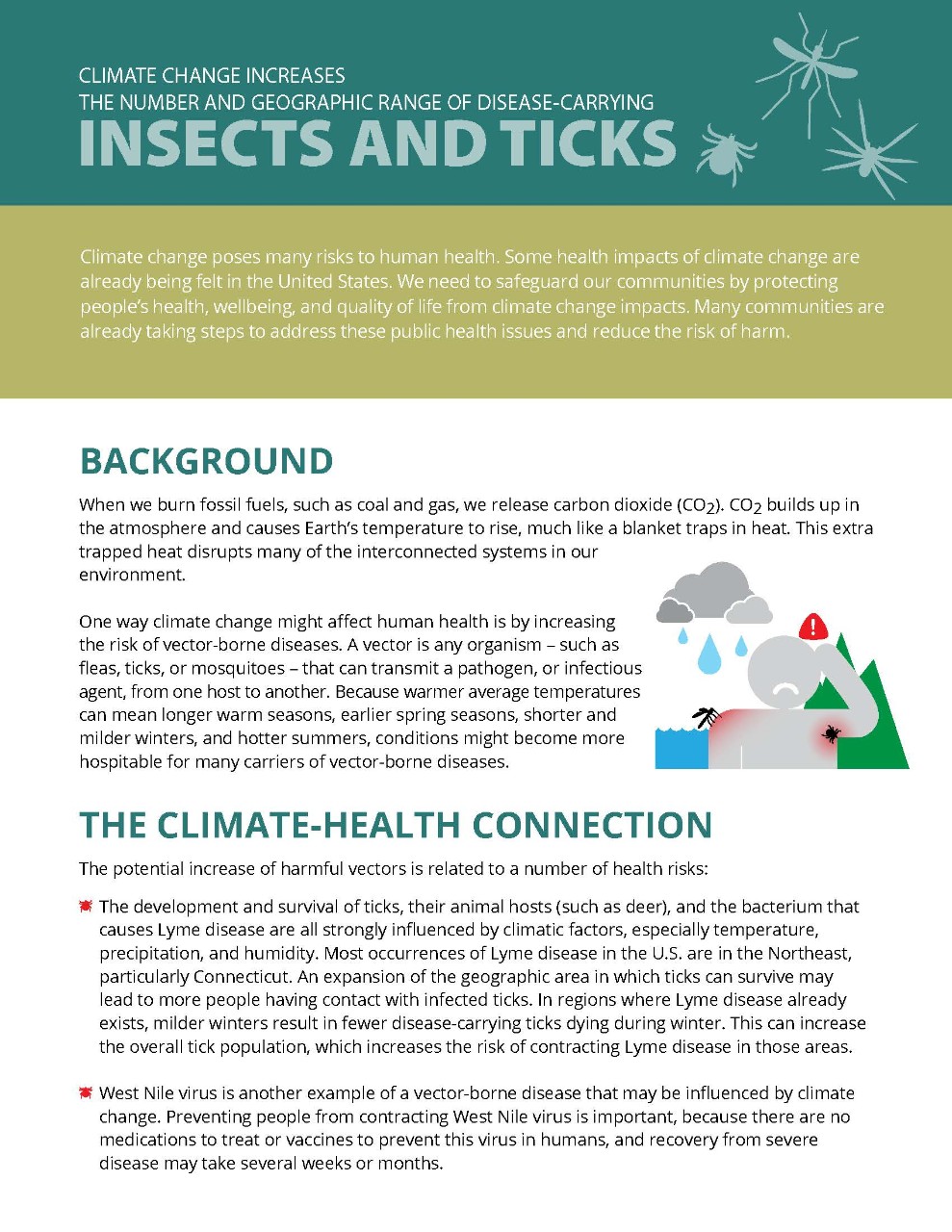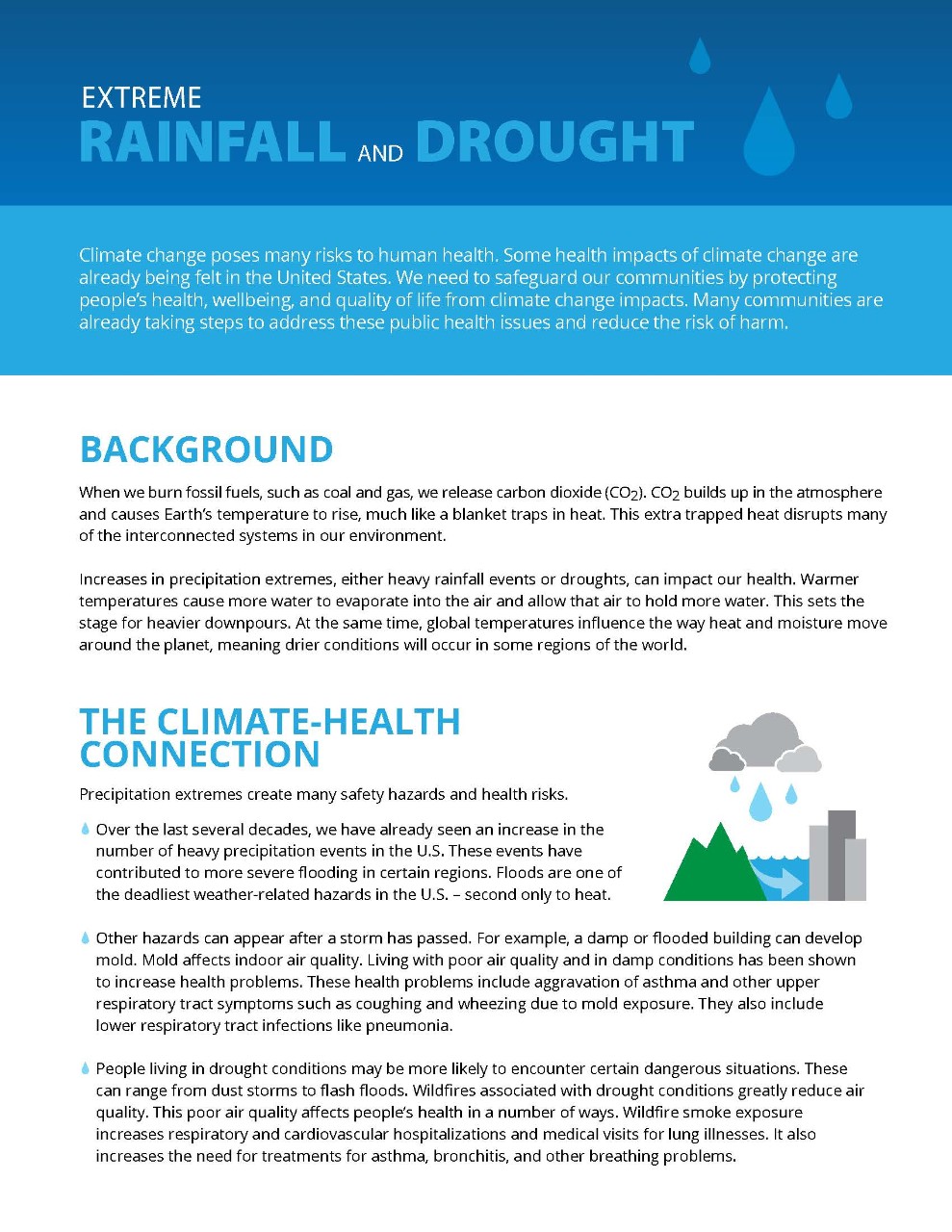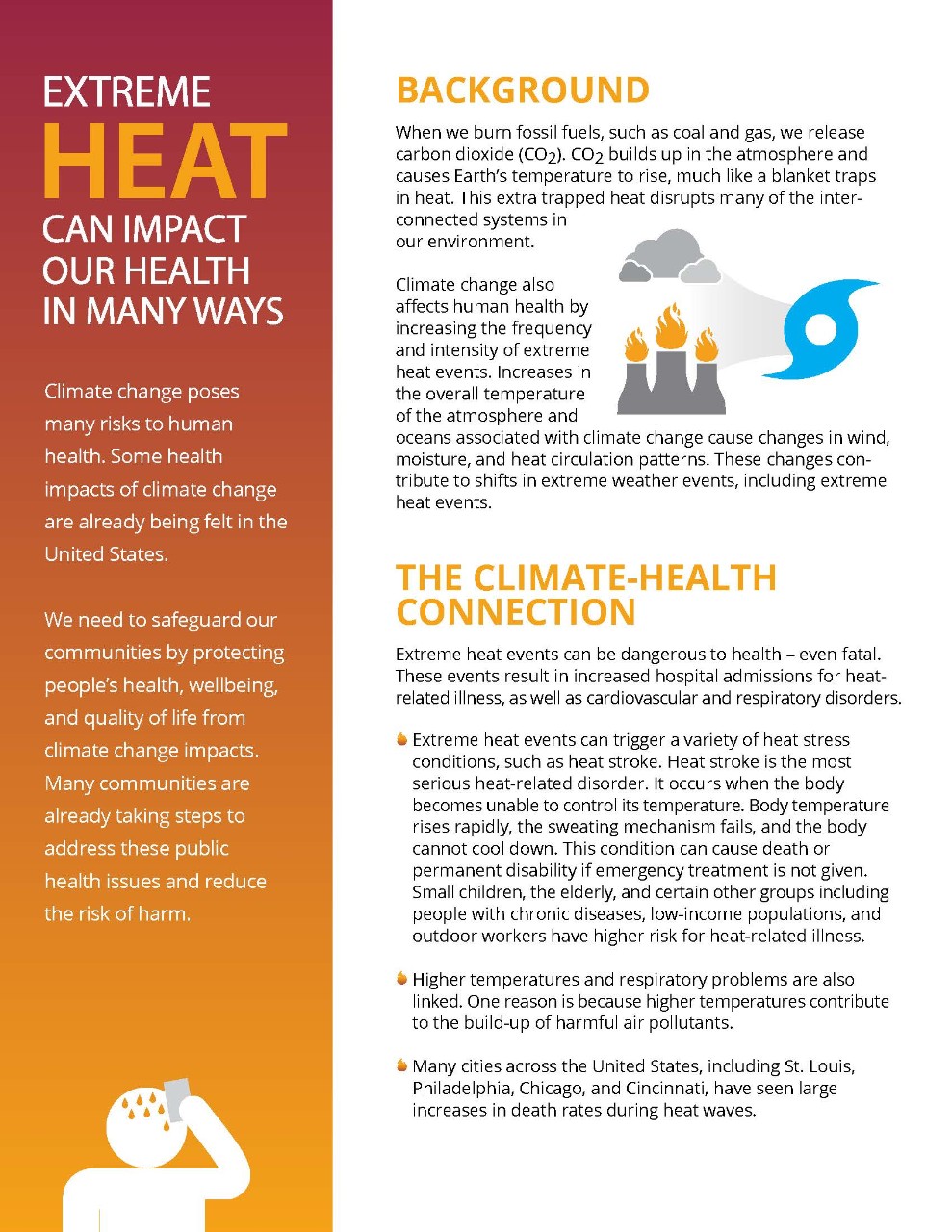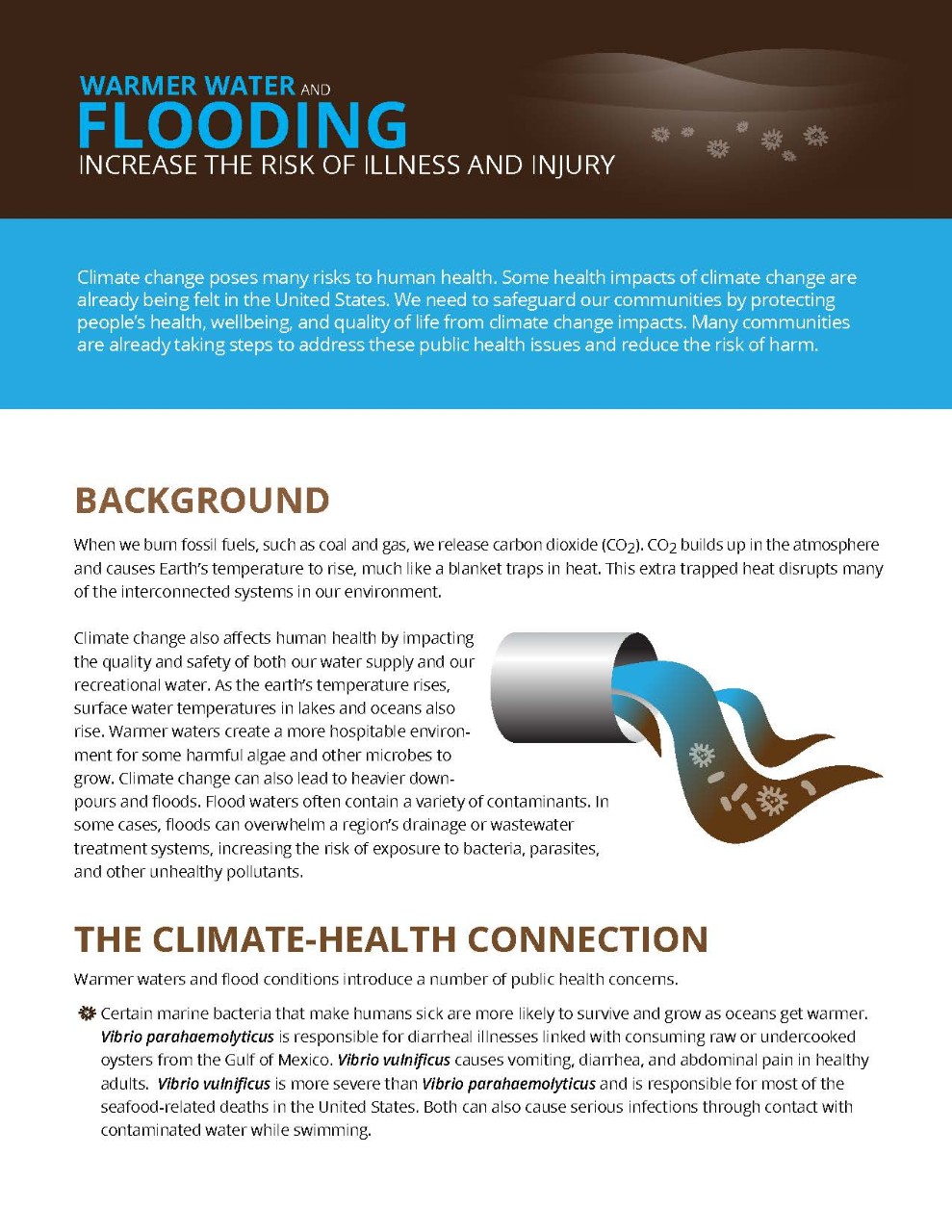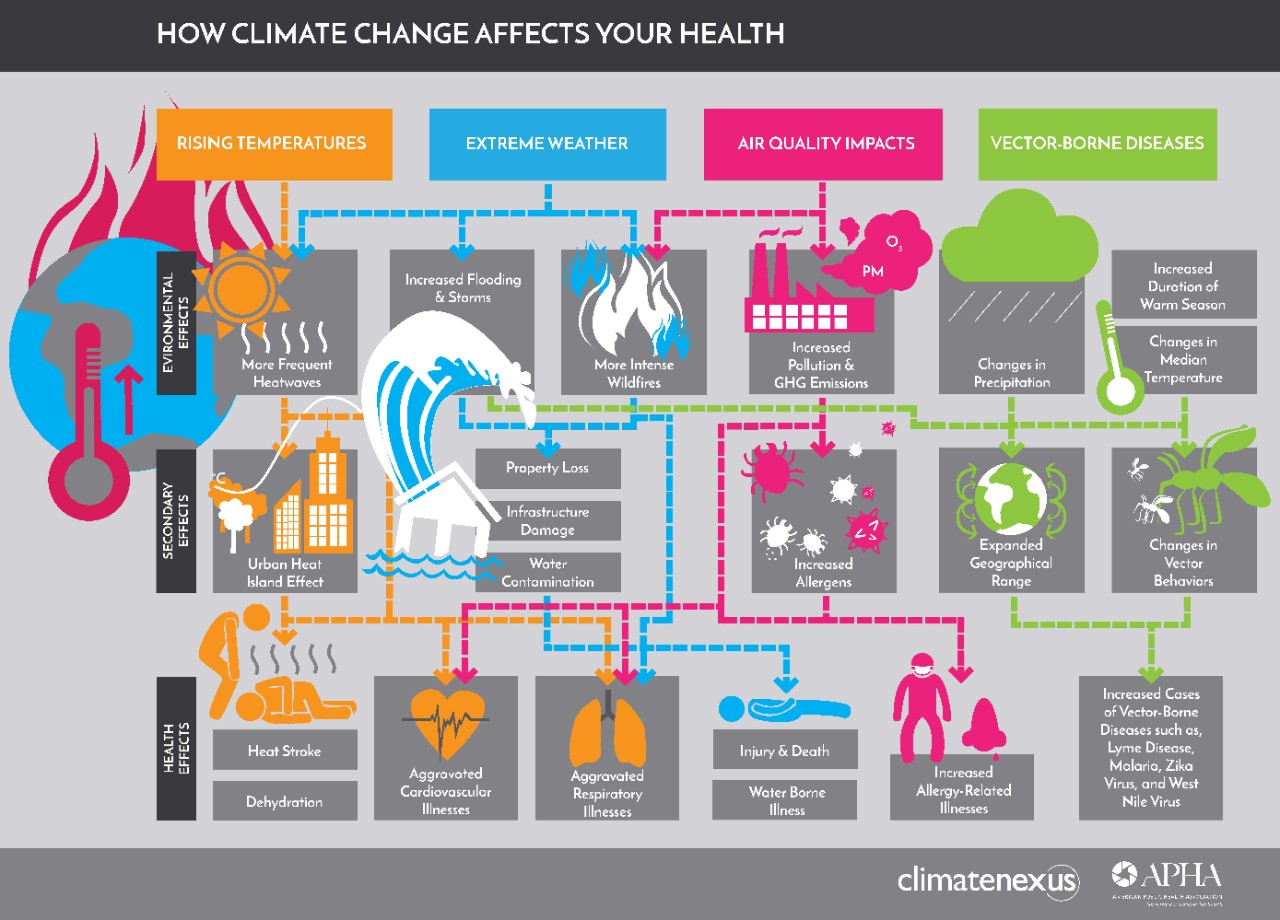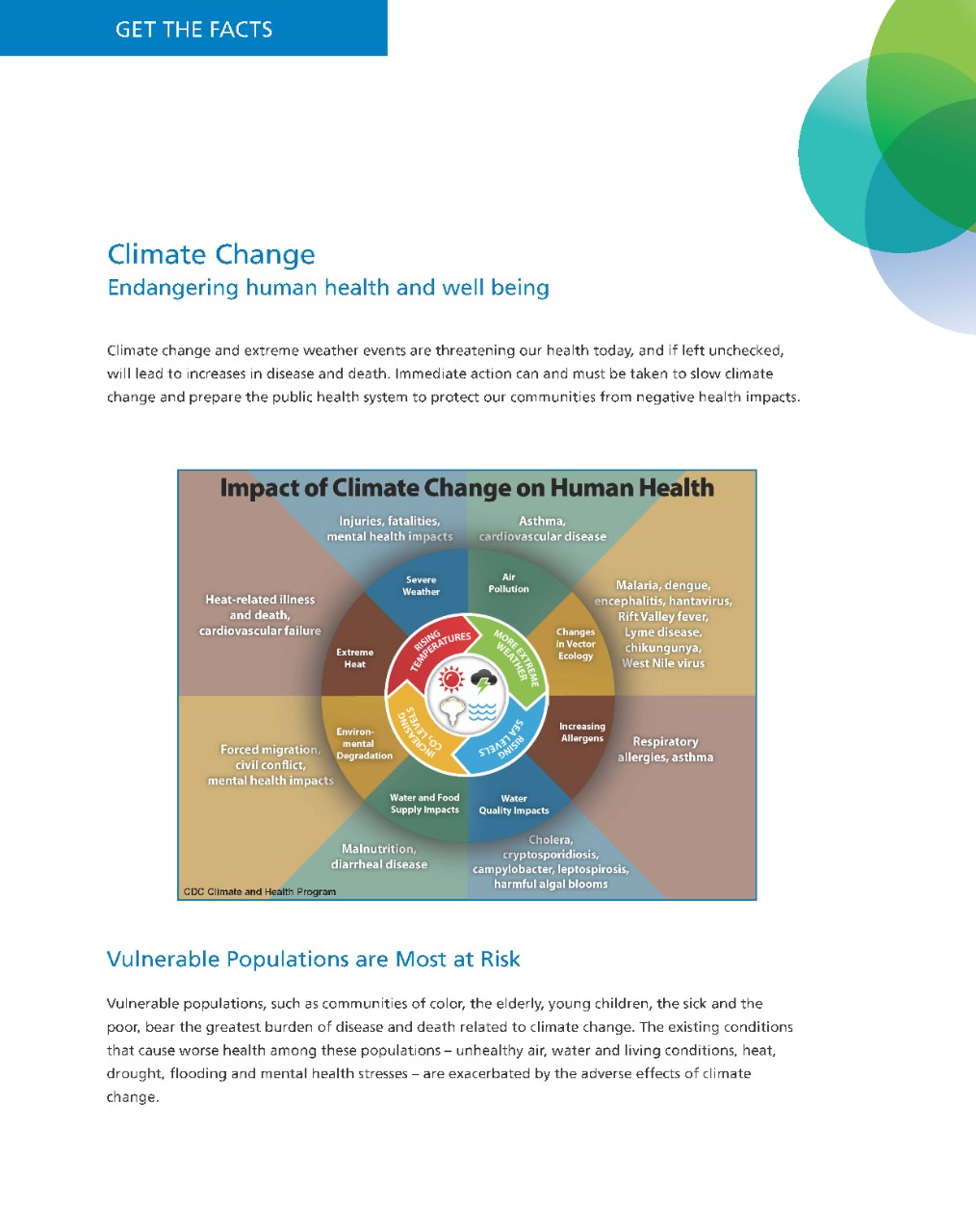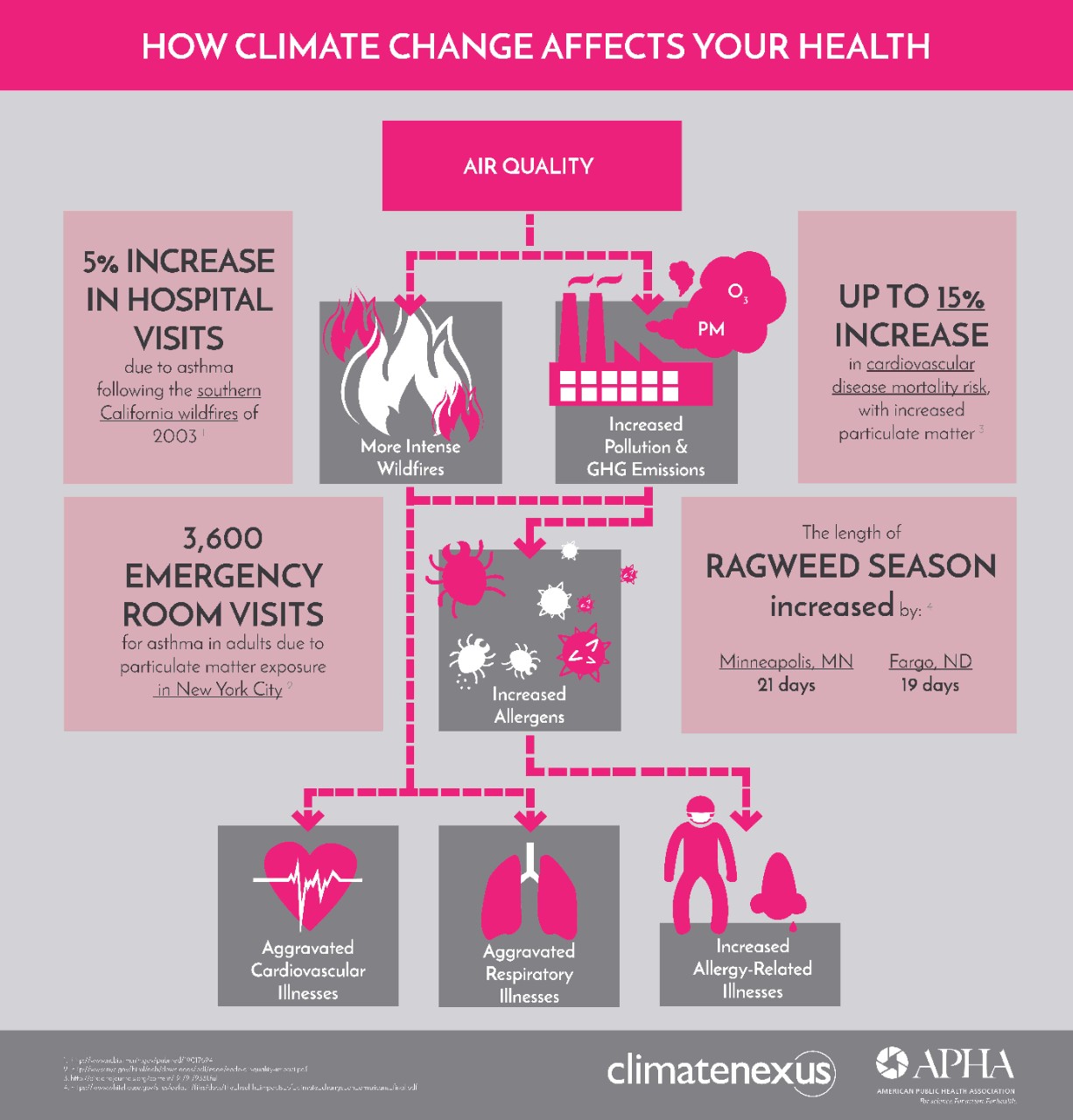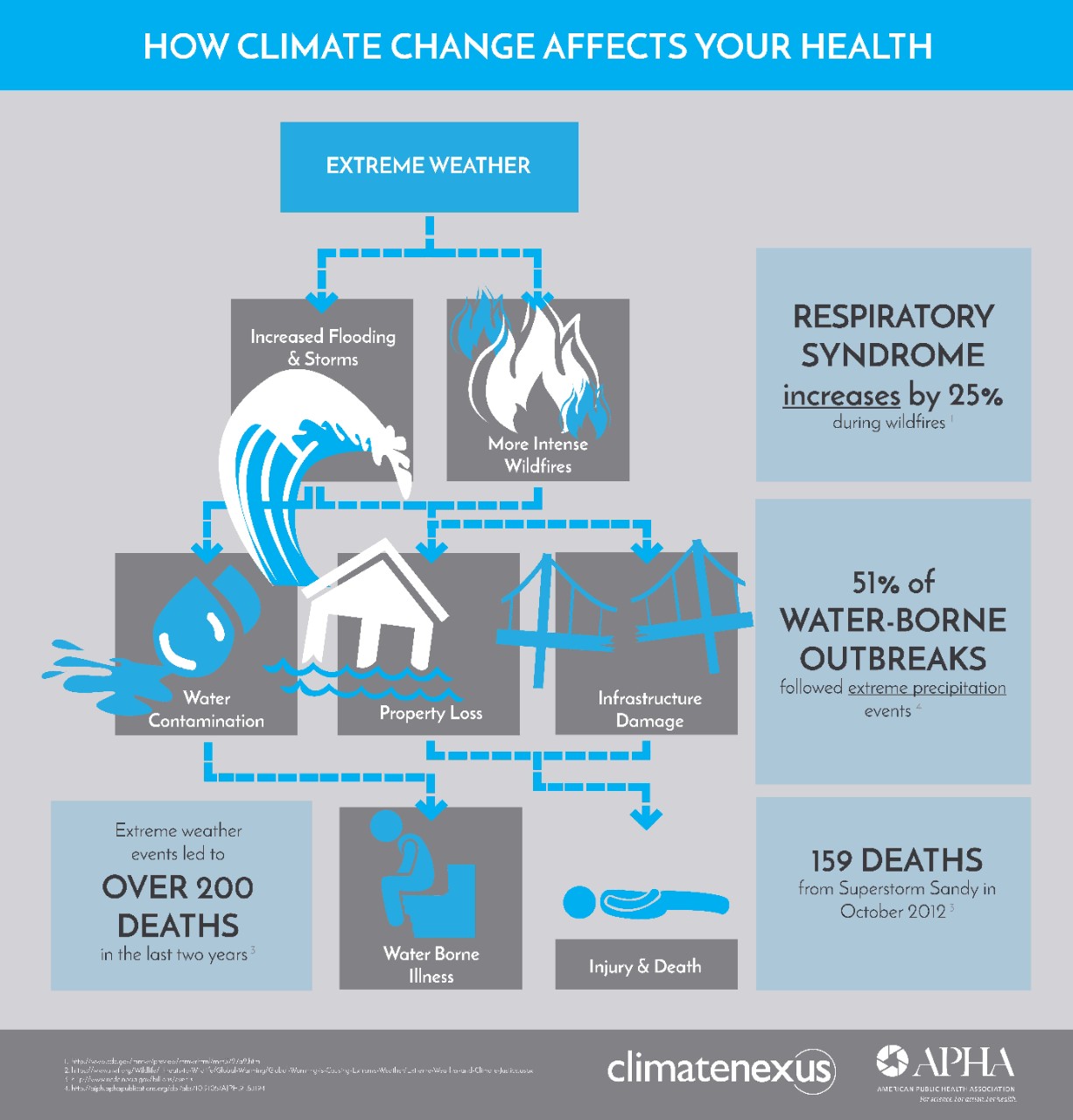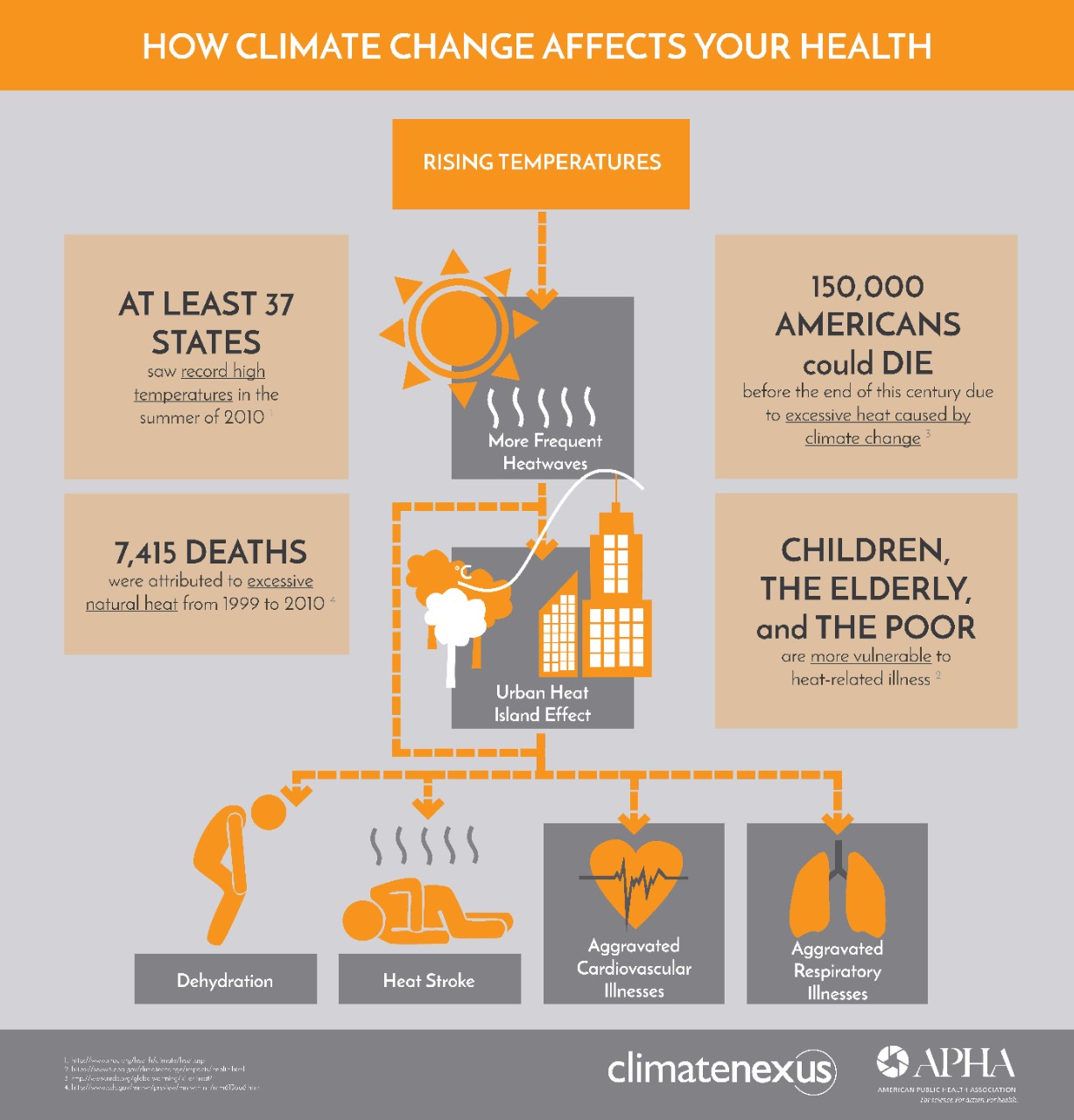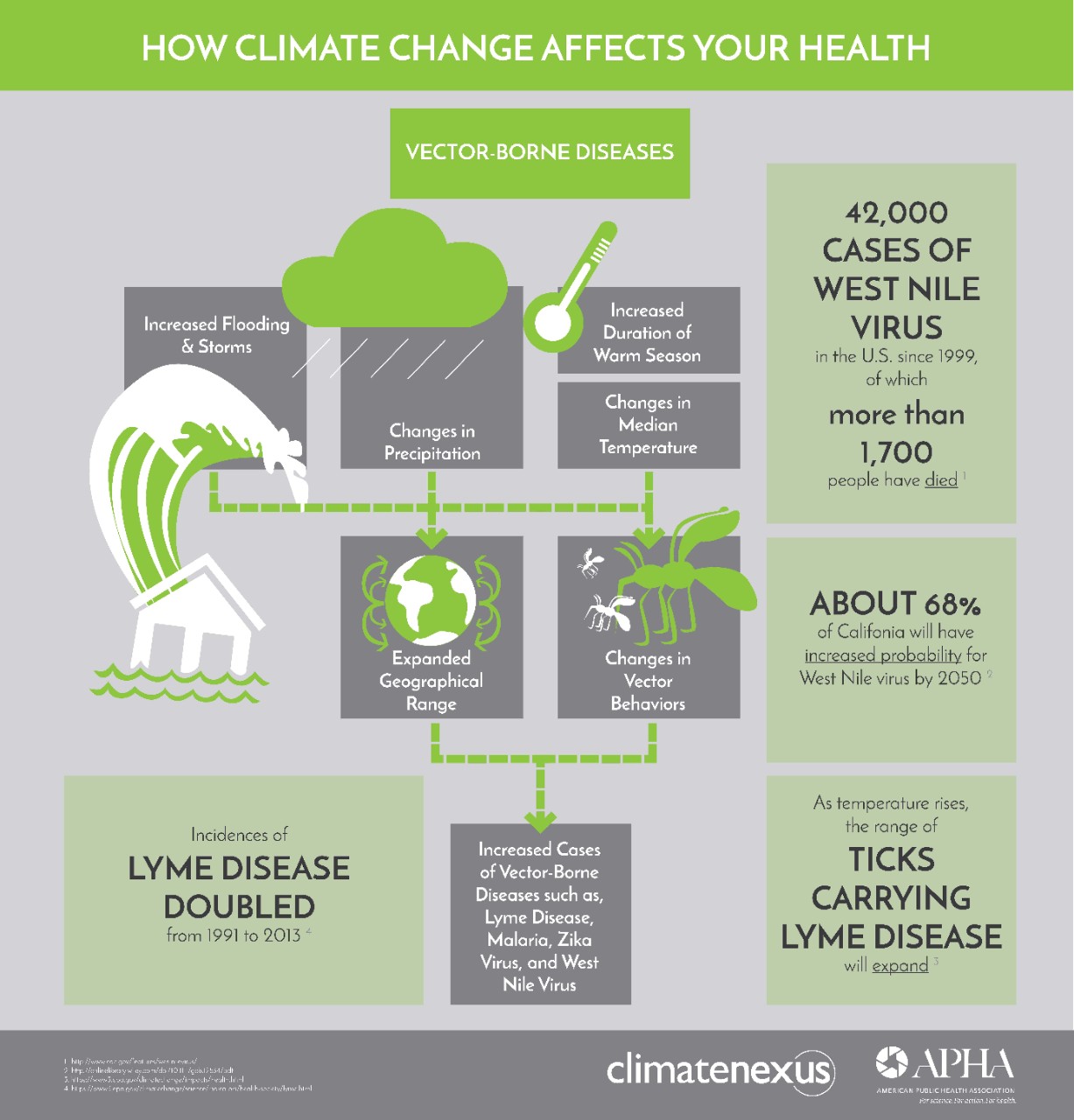Climate Change and Public Health
Potential Impacts on Human Health
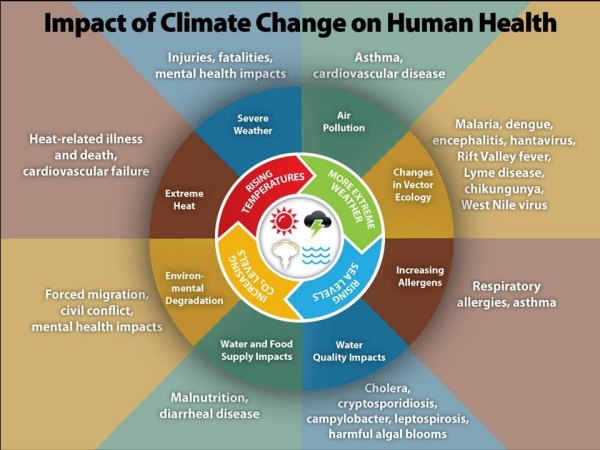
The activities of humans release pollutants into the Earth’s atmosphere. Some of these pollutants are greenhouse gases that can trap the Sun’s energy. The result has been a gradual increase in the temperature of the Earth's atmosphere. The result of this global warming has been global climate change.
Increased global temperature, rising sea levels, and precipitation changes, with more extremes in weather, are expected to have ill effects on public health. Increased morbidity, mortality, and displacement are expected due to global climate change. The graphic above shows the potential impacts of global climate change on human health.
Potential Impacts of Global Climate Change on Human Health Changes in global climate are expected to adversely affect communities worldwide. Storms will be more intense and flooding more common. Higher temperatures will lead to heat-related illnesses and longer allergy seasons. Droughts could be more persistent while arctic sea ice and spring snowpack shrink. Changes in rainfall amounts will lead to disruptions in the global food supply. The number, size, and strength of wildfires is predicted to increase. Organisms that transmit viruses and other pathogens will be able to infect people in larger geographic ranges. Air pollution will trigger more respiratory diseases. Mental health and stress-related disorder could increase. Altering the basic human needs of food, clean water, clean air, and shelter is likely to result in civil conflict.
Sadly, these changes are expected to have disproportionate effects on people. People without access to health care will likely suffer more. People who are very young or very old are usually less able to cope with sudden changes. People and nations without wealth will be less able to respond to rapidly changing living conditions. Extreme events can strain on our health system and emergency services. Climate-related economic impacts such as financial losses from flooding, changes in crop yield, and increased patients seeking care for heat-related illness at medical facilities have also been observed. Reduction of greenhouse gases and adaptation are both important strategies to mitigating the human health and economic impact of climate change.
Click on the tabs above to learn more about climate resilience and adaptation, opportunities for public health response, things you can do to mitigate climate change risks, and for more websites and publications about climate change and public health.
Resilience
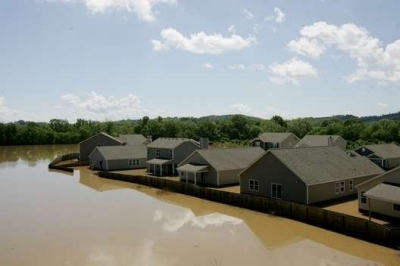
Resilience is the ability to bounce back. Building resilient communities is important to get communities back to normal living and economic conditions after events like severe weather, accidents, or natural disasters. Terms like resilience, disaster risk reduction, and adaptation are often used when planning to cope with the changing climate. In Tennessee, opportunities for adjusting to climate change include farmers planting more drought-resistant crops and riverside communities building infrastructure well above flood stage.
More and more people are living in cities. Today more than half of the world's population lives in cities. While grouping people in cities helps to leave some green countryside, the increased amount of impervious surfaces in cities leads to more radiant heat creating urban heat islands. Extreme weather events with increased rain on impervious surfaces can lead to storm water issues and flooding. Increased temperature combined with urban heat islands can lead heat-related illness and poor air quality.
Governments and communities that plan now can limit the potential damages of future climate change. Resilient communities protect their valuable infrastructure, maintain their residents property values, conserve their natural resources, often improve their sense of place and livability, maybe even improve their tourism, and should bounce back to functionality much more quickly should the unthinkable happen. The U.S. Climate Resilience Toolkit website is a great place to start planning. Also, click on the Resources tab for more websites and publications about climate resilience and adaptation.
Public Health Response
An effective public health response to climate change can prevent injuries, illnesses, and death while enhancing overall public health preparedness. Protecting Americans from adverse health effects of climate change directly correlates with the Centers for Disease Control and Prevention’s four overarching Health Protection Goals of: Healthy People in Every Stage of Life, Healthy People in Healthy Places, People Prepared for Emerging Health Threats, and Healthy People in a Healthy World.
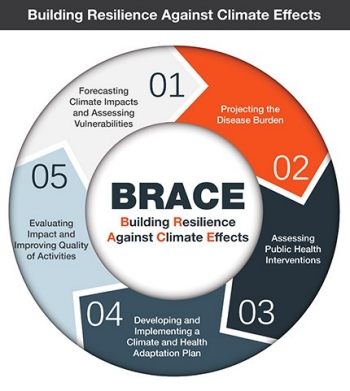
The CDC developed Building Resilience Against Climate Effects (BRACE). The BRACE framework is a five-step process that allows health officials to develop strategies and programs to help communities prepare for the health effects of climate change. The BRACE framework has 5 steps to: (1) anticipate climate impacts and assess vulnerabilities, (2) project disease burden, (3) assess public health interventions, (4) develop and implement a climate and health adaptation plan, and (5) evaluate impact and improve quality of activities. The framework and additional resources are available on CDC's BRACE website.
Public Health programs provide a solid foundation for action and policy. Many of the activities needed to protect Americans from adverse health effects due to climate change are mutually beneficial for overall public health. Human health and the environment are connected. What is generally good for the environment is good for human health.
Tennessee Department of Health former Commissioner, Susan R. Cooper, testified before the United States Senate Environmental Public Works Committee. Representing the Association of State and Territorial Health Officials (ASTHO), she spoke about the human impacts of climate change. Click here to read the statement.
You can make a difference
Climate change is a global issue. It might be hard to believe that you can have an affect on a global issue, but you can. Whether your affect on climate change is positive or negative is up to you. There are many simple things you can do in your daily life to help keep our planet healthy. See below for actions you can do to green your home or workplace. Also available are slideshows for making changes at home and at work. Our positive actions make a difference.
Buy Energy Star qualified appliances and products
|
Conserve water
|
Be fuel efficient
|
Make your home energy efficient
|
Be Green in your yard
- Compost food and yard wastes
- Use gasoline-powered equipment during cooler parts of the day
Reduce, reuse, recycle
|
Ways to have an environmentally friendly workplace
|
Websites about Climate Change
- Centers for Disease Control and Prevention (CDC)
- National Institute of Environmental Health Sciences: Human Health Literature Portal
- Environmental Protection Agency (EPA)
- George Washington University - 53 Resources for Climate Change News
- Koshland Science Museum
- National Aeronautics and Space Administration (NASA)
- National Oceanic and Atmospheric Administration (NOAA)
- World Health Organization (WHO)
- United Nations Environment Program (UN)
- Environmental Health Perspectives Journal (EHP)
- Center for Climate Change and Health: A Framework for Action
- U.S. Climate and Health Alliance
Reports and Publications about Climate Change
- U.S. Global Change Research Program Climate and Health Assessment
- Journal of Environmental Health Perspectives: An Evidence-Based Public Health Approach to Climate Change Adaptation (PDF 202 kb)
- U.S. EPA Climate Change and Health Effects fact sheet (PDF 407 kb)
- U.S. EPA Climate Change Indicators in the United States, 2014, third edition (PDF 25 MB)
- U.S. EPA Climate Smart Brownfields Manual (PDF 15 MB)
- The White House: Preparedness and Resilience Task Force Report (PDF 12 MB)
- World Health Organization: Health in the Green Economy Transportation Sector (PDF 181 kb)
- Alliance of Nurses for Healthy Environments: Advancing Clean Air, Climate, & Health, Opportunities for Nurses (942 kb)
- U.S. Department of Defense: 2014 Climate Change Adaptation Roadmap (1.6 MB)
- George Mason University Center for Climate Change Communication: Public Perceptions of the Health Consequences of Global Warming, October 2104 (4.5 MB)
